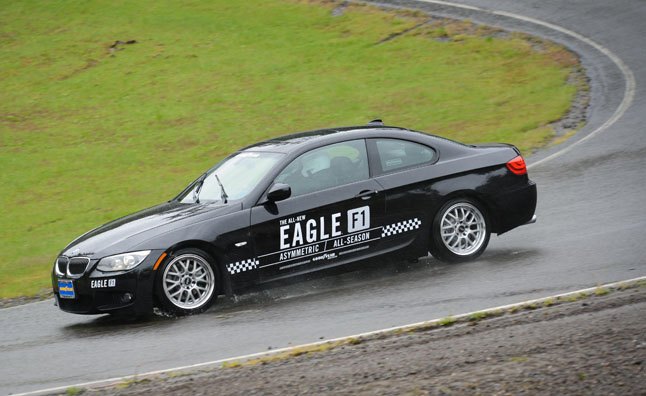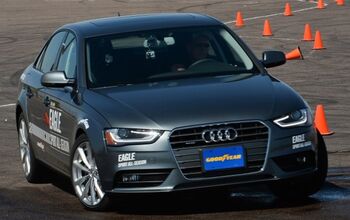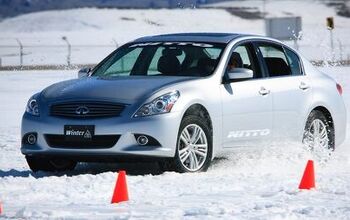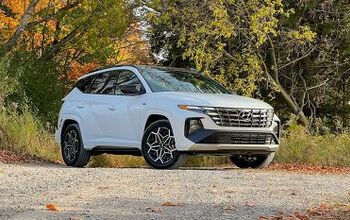The All Season High Performance Tire: Myth or Reality?
The Goodyear Eagle F1 Asymmetric All Season is a mouthful. Mind you, when it comes to high performance tires, this one’s key rivals, the Bridgestone Potenza RE960/970 and Michelin Pilot Sport A/S Plus, don’t exactly roll off the tongue either.
Names aside, Goodyear’s latest addition to the Eagle F1 range is designed to maintain high performance while adding all-season attributes. And when it comes to finding a place to give such a tire a good workout, the Pacific Northwest is probably as good a place as any.
FILLING A NEED
If you look around today, there’s an unmistakable trend emerging in auto land and that trend is for more and more vehicles to be equipped with performance tires. Whether it’s lowly sedans or even crossovers, many bread and butter conveyances today sport rim sizes and rubber profile dimensions that several years ago would have been exclusively the domain of sports and ultra high performance machines.
As a result, both at the OE and replacement level, demand for performance rubber designed to cope with a wide range of different driving conditions has been steadily increasing.
Goodyear feels that the market is ready for an all-season high performance derivative of its Eagle F1 Asymmetric 2, the All Season. This latest tire, which will be available from retailers in July, combines the attributes of its “summer” counterpart, with added features designed to improve traction on wet surfaces and even snow. As a result, it sports an asymmetric tread pattern with a “dry handling” zone on the outside but also features a specialized tread compound with Functionalized Polymers designed to optimize grip in both dry and wet conditions.
In addition, what Goodyear calls “TredLock Technology,” is incorporated, essentially microgrooves that are designed to promote better stability, especially under wet conditions and during heavy handling maneuvers. There are also traction teeth on the outer edge, designed to further enhance bite during rain and snow conditions; the idea being that this is a tire that you can actually drive in all four seasons.
FAST FACTS
1. A total of 36 different sizes will be available from July.
2. A 45,000-mile tread warranty is standard.
3. Testing was conducted all over the world, including winter driving in New Zealand.
4. For performance, engineers benchmarked a NASCAR slick when developing this tire.
5. Goodyear is offering a national ride and drive program to enable customers to experience the Eagle F1 Asymmetric All Season firsthand.
WET, WET, WET
So when it comes down to it, is that true? It probably boils down to what kind of winter weather you experience. Truly cold temperatures still require specialized rubber compounds and polymers designed to offer a greater contact and traction surface, so in those conditions, only a dedicated winter performance tire will do.
However, for much of the country, something like the Eagle F1 Asymmetric All Season might just fit the bill. During our testing day, the weather hovered around 50 degrees Fahrenheit and there was enough rain on the track for the late Ayrton Senna to be proud.
Behind the wheel of a BMW 328i (the 3-Series was the car used as the benchmark when engineers developed this new tire), the Goodyear Eagle F1 Asymmetric All Season proved its worth. Goodyear has extensive experience developing tires optimized for wet weather traction and frankly, it shows. Under acceleration we noticed minimal wheel spin and although hydroplaning is a problem exhibited with all tires, the BMW we tested didn’t feel particularly twitchy – a slight correction of the steering was all that was required when hitting patches of standing water. Under heavy braking, there was also less of a tendency for the car to slide once the ABS kicked in, unlike many other equivalent high performance tires in the wet.
Decreasing radius corners proved a particularly interesting experience. Under dry conditions, in a rear-drive car like this, a wide line and late braking is most definitely encouraged. Through some water on the track however and the situation changes rapidly.
An experienced driver can still use the late braking technique to their advantage, but there’s much more a tendency for the car to understeer; that’s why it’s essential to have tire technology that dissipates water as quickly as possible. And in the case of the Eagle F1 Asymmetric All Season, we noticed that, while the car still had a tendency to run wide, there wasn’t anywhere near the understeering drama we’ve come to generally expect under such conditions from high performance rubber. Sure, careful throttle application and steering input was essential to maximize grip to the back tires and rotate the car through the corner, but minimal velocity was lost.
By comparison, the same car outfitted with rival Bridgestone RE960 rubber, proved much harder to drive on the same course and under the same conditions, requiring greater steering input and lower cornering speeds to maintain a good racing line. Because we didn’t have any dry conditions, we weren’t able to compare both tires under such test environments, though in the wet, there’s no question Goodyear has done its homework.
RIDE, BABY RIDE
Besides good performance, another important aspect of any modern tire concerns ride quality. Today, most consumers simply won’t put up with rubber that jostles your kidneys over all but the smoothest of road surfaces. Under street driving conditions, the F1 Asymmetric is noticeably firm but not harsh to the point that it becomes tiresome, even on an Audi A3, which has to be said, doesn’t have one of the most compliant rides in the compact car segment.
If there was any area where perhaps the Eagle F1 Asymmetric All Season could use improvement, it is in the area of road noise. Granted, for much of our street drive, we were on fairly rough surfaces but still, the noise was enough to make you aware of it and certainly in many parts of the Northwest, motorists have to contend with those kind of road surfaces every day.
THE VERDICT
Although nobody has yet come up with a tire that can do everything in all conditions, the Goodyear Eagle F1 Asymmetrical All Season does an admirable job in providing high levels of grip and driver confidence, particularly in wet conditions. And, given Goodyear’s legacy in developing wet weather performance tires (Ayrton Senna was riding on a set of the company’s F1 rain tires when he won his first Grand Prix at a rain soaked Estoril, Portugal back in 1985), it appears the new Eagle F1 Asymmetrical All Season builds on an already solid legacy while giving fewer reasons than ever to compromise when it comes to purchasing a set of high performance tires.
GALLERY: Goodyear Eagle F1 Asymmetrical All Season Tire Test
Excellent wet weather traction
Confidence inspiring in the rain
Superior under braking
Road noise
True winter performance?
Could be offered in more sizes
More by Huw Evans
































Comments
Join the conversation
How is it in ice and snow??? You know...these are suppose to be "ALL SEASON" tires....